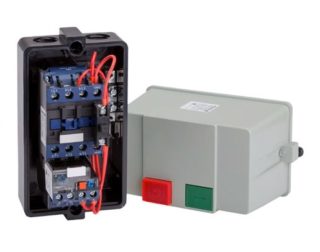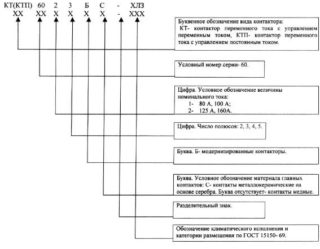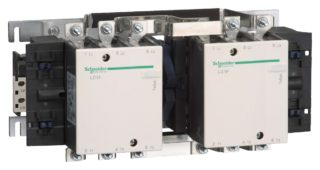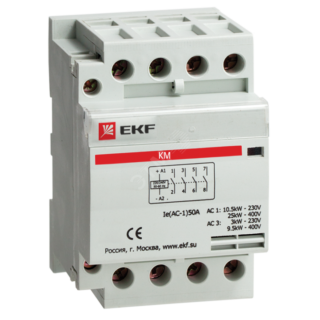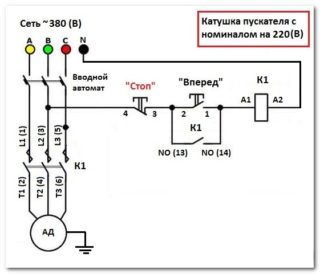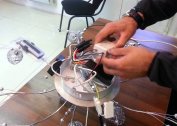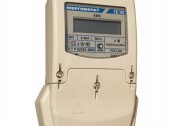Widely used in electrical engineering, electromagnetic contactors (CMs) are special devices that can switch large currents. A feature of these power devices is the ability to control load currents through circuits that are not structurally related to the switched load. To understand the essence of the processes occurring in contactors, you should familiarize yourself with the principle of their work.
Design and principle of operation
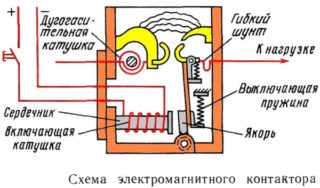 The main difference between the 220/380 Volt electromagnetic contactor and other switching devices is the use of part of the voltage that is to be switched in the control circuit. This difference is easiest to understand if you familiarize yourself with a typical KM device. This power device consists of the following main components and parts:
The main difference between the 220/380 Volt electromagnetic contactor and other switching devices is the use of part of the voltage that is to be switched in the control circuit. This difference is easiest to understand if you familiarize yourself with a typical KM device. This power device consists of the following main components and parts:
- Power contacts that provide current directly to the consumer or to the electrical installation.
- A set of springs used in the design as elements that create downforce.
- A plastic beam connected to a movable armature and used to attach contact jumpers.
- An electromagnetic coil that controls the position of the beam and changes with it the state of the contactor.
The switched contacts themselves are made of copper alloys, which ensures high electrical conductivity and reliability.
After applying voltage to the electromagnet, the armature under the influence of the field shifts down and attracts the beam with contacts in the same direction. The movable parts of the contactor fixed on it are closed with fixed heels, creating a flow chain for the current. When the voltage is removed from the electromagnet, the armature under the action of the spring returns to its original state and the contacts open. For a freelance shutdown, it has a special button-switch that is installed in the additional switching circuit.
The principle of operation of a switching device helps to understand how contactors differ from a relay or any other switching device: relays and contactors are designed for different magnitudes of currents, varying tens or even hundreds of times.
Differences of contactors from magnetic starters
In terms of functionality, these two devices are no different. They allow you to switch power circuits and have in their composition from two (single-phase contactor) to four "powerful" contacts. The difference begins to appear when considering the following features of these devices:
- dimensions and weight of the device;
- contact switching zone design;
- direct appointment.
Usually, electromagnetic starters are called "small contactors", which indicates their difference in size and weight. But this is not limited to this, since the fact that contactor pairs have special chambers for extinguishing the arc is not taken into account. Thanks to these housing elements, the contactor does not have an electric contactor, it is installed in locked rooms without access by unauthorized persons.
The power contacts of the magnetic starter are hidden under reliable plastic covers, but do not have blanking chambers. In this case, the devices themselves are installed in a circuit with a limited amount of switched current. Hence the third difference of devices, consisting in their purpose.
The three-phase contactor can be installed in any power line, providing reliable connection and disconnection of an arbitrary load. Magnetic starters are traditionally used for switching control circuits of asynchronous motors and are capable of starting them in various modes, including reverse.
Marking and types
To distinguish between individual models of three-phase and single-phase contactors, the following symbol or marking is used: CT (KTP) - X1 X2 X3 X4 C (A or B) X5. They are decrypted as follows:
- the first icon corresponds to the series number (60 or 70);
- the second - the dimensions of the contactor from the following series: 0, 1, 2, 3, 4, 5, 6№;
- X3 - the total number of poles (2, 3, 4 or 5);
- X4 (letters A, B or C) indicate the specifics of the series in terms of the features of the switching contacts;
- X5 is an indicator of climatic performance: U3, UHL or T3.
Different types of contactors are classified according to the following criteria:
- available protective equipment and operating voltage (220 or 380 Volts);
- contact triggering method;
- the number of contacts in the power group.
Almost all models of contactors are equipped with solid-state thermal relays that open the load circuit during overcurrent like a circuit breaker. After disconnecting the contacts and cooling the protective circuit breaker, it is necessary to turn the device back on. In accordance with the supply voltage of the device itself, their coil can be designed for both 220 and 380 volts.
In practice, there are DC contactors, so-called in accordance with the type of control action. A typical representative is a 12 volt DC contactor.
The nature of the contacts
By the nature of the circuit, the following types of contactors are distinguished:
- Direct connection devices with only one group of power contacts. They only work on and off and have protection against overload or short circuit.
- Reversible devices equipped with two groups. With their help, it is possible to adjust the load switching circuit, changing the sequence of phases, for example.
- Devices with a limited set of switching: only for closing or only for opening.
The latter variety is used if necessary to control two electrical installations in antiphase. In this mode, one of them is connected to the line, and the second synchronously de-energizes with it.
Number of contacts
By the number of contacts of the power group, the devices are divided into the following varieties:
- 2-pin devices for single-phase circuits;
- 3-pin devices, switching only phase groups, zero does not start on them;
- with four or more contacts in power groups.
A switching group refers to a set of normally closed or normally open contacts.
The latter type of product is used extremely rarely, only in special connection schemes.
When considering the varieties of devices of this class, it is impossible not to mention modern analogues represented by thyristor AC contactors. In these devices, purely mechanical contacts are replaced by electronic transitions characteristic of semiconductor contactors.
Self connect
Before installing a single-phase contactor in a cabinet on a din-rail, and independently connecting it, it is necessary to pay attention to the presence of two chains in the circuit. One of them is power, and the second signal, through which it is possible to control the operation of the device. For this chain to work, after installing the device in the cabinet, it will be necessary to supply power to its contacts, traditionally referred to as A1 and A2. They are supplied with exactly the voltage for which the contactor coil is designed.
The switched power circuit is connected to the terminals located at the bottom of the device and usually indicated by the T1, T2, T3 icons. Thanks to their presence, it is possible to implement a connection scheme for a three-phase contactor. With this inclusion, you can control the power circuits that make up any power generating unit, including wind and diesel generators.The type of voltage they generate is also irrelevant.
Major malfunctions
Possible breakdowns of contactors include the failure of the magnetic control coil, as well as the burning and failure of the switching contacts themselves. In the first case, the only possible way out is to replace the coil with a new, working sample. When burning the contacts, you can try to repair them by slightly cleaning the damaged places with a file first and then with a fine sandpaper. However, such a “cosmetic” operation is not a way out. Sooner or later, the user will have to replace the burnt contacts with new (backup) or samples taken from another device.
